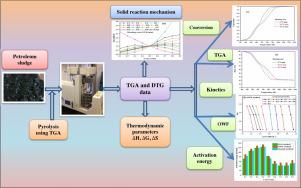当前位置:
X-MOL 学术
›
Process Saf. Environ. Prot.
›
论文详情
Our official English website, www.x-mol.net, welcomes your feedback! (Note: you will need to create a separate account there.)
In-depth analyses of kinetics, thermodynamics and solid reaction mechanism for pyrolysis of hazardous petroleum sludge based on isoconversional models for its energy potential
Process Safety and Environmental Protection ( IF 7.8 ) Pub Date : 2021-02-01 , DOI: 10.1016/j.psep.2020.08.038 Bineeta Singh , Satyansh Singh , Pradeep Kumar
Process Safety and Environmental Protection ( IF 7.8 ) Pub Date : 2021-02-01 , DOI: 10.1016/j.psep.2020.08.038 Bineeta Singh , Satyansh Singh , Pradeep Kumar

|
Abstract The pyrolysis of hazardous petroleum sludge (PS) has widely been used for its remediation and energy extraction. However, in view of process optimization, scale-up, design and simulation, the kinetic (activation energy and frequency factor) and thermodynamic parameters (change in enthalpy ( Δ H), entropy ( Δ S), and Gibb’s free energy ( Δ G)) along with reaction mechanism followed by pyrolysis has rarely been investigated. Therefore, pyrolysis of PS was investigated in thermogravimetric analyzer (TGA) at three heating rates viz. 5, 10, 15 K min−1. The kinetic and thermodynamic parameters were estimated by iso-conversional methods such as Kissinger-Akahira-Sunose (KAS), Starink and Ozawa-Wall- Flynn (OWF) method. Further, solid reaction mechanism during pyrolysis was examined by employing Criado method (Z-master plot). The effect of heating rate on thermodynamic parameters and solid reaction mechanism was also examined. The average activation energy using Starink method was found to be 76.77 kJ mol−1. The frequency factor, Δ H, Δ S and Δ G at 5 K min−1, using activation energy from Starink method was found to be 3.23 × 107 sec-1, 70.78 kJ mol−1, -0.168 J mol-1 K-1, and 189.88 kJ mol−1, respectively. Z-master plot revealed that solid reaction mechanism depend on the degree of conversion and heating rate during pyrolysis of PS.
中文翻译:

基于等转化模型的危险石油污泥热解动力学、热力学和固体反应机理深入分析其能量势
摘要 有害石油污泥(PS)的热解已被广泛用于其修复和能源提取。然而,考虑到工艺优化、放大、设计和模拟,动力学(活化能和频率因子)和热力学参数(焓变化 (ΔH)、熵 (ΔS) 和吉布斯自由能 (ΔG) )) 以及热解之后的反应机制很少被研究。因此,在热重分析仪 (TGA) 中以三种加热速率研究 PS 的热解。5, 10, 15 K min−1。动力学和热力学参数通过等转化方法估计,例如 Kissinger-Akahira-Sunose (KAS)、Starink 和 Ozawa-Wall-Flynn (OWF) 方法。此外,通过使用 Criado 方法(Z-master plot)检查了热解过程中的固体反应机理。还研究了加热速率对热力学参数和固体反应机理的影响。发现使用 Starink 方法的平均活化能为 76.77 kJ mol-1。频率因子 Δ H、Δ S 和 Δ G 在 5 K min-1,使用 Starink 方法的活化能被发现为 3.23 × 107 sec-1, 70.78 kJ mol-1, -0.168 J mol-1 K-分别为 1 和 189.88 kJ mol−1。Z-master 图显示固体反应机理取决于 PS 热解过程中的转化程度和加热速率。分别为 88 kJ mol−1。Z-master 图显示固体反应机理取决于 PS 热解过程中的转化程度和加热速率。分别为 88 kJ mol−1。Z-master 图显示固体反应机理取决于 PS 热解过程中的转化程度和加热速率。
更新日期:2021-02-01
中文翻译:

基于等转化模型的危险石油污泥热解动力学、热力学和固体反应机理深入分析其能量势
摘要 有害石油污泥(PS)的热解已被广泛用于其修复和能源提取。然而,考虑到工艺优化、放大、设计和模拟,动力学(活化能和频率因子)和热力学参数(焓变化 (ΔH)、熵 (ΔS) 和吉布斯自由能 (ΔG) )) 以及热解之后的反应机制很少被研究。因此,在热重分析仪 (TGA) 中以三种加热速率研究 PS 的热解。5, 10, 15 K min−1。动力学和热力学参数通过等转化方法估计,例如 Kissinger-Akahira-Sunose (KAS)、Starink 和 Ozawa-Wall-Flynn (OWF) 方法。此外,通过使用 Criado 方法(Z-master plot)检查了热解过程中的固体反应机理。还研究了加热速率对热力学参数和固体反应机理的影响。发现使用 Starink 方法的平均活化能为 76.77 kJ mol-1。频率因子 Δ H、Δ S 和 Δ G 在 5 K min-1,使用 Starink 方法的活化能被发现为 3.23 × 107 sec-1, 70.78 kJ mol-1, -0.168 J mol-1 K-分别为 1 和 189.88 kJ mol−1。Z-master 图显示固体反应机理取决于 PS 热解过程中的转化程度和加热速率。分别为 88 kJ mol−1。Z-master 图显示固体反应机理取决于 PS 热解过程中的转化程度和加热速率。分别为 88 kJ mol−1。Z-master 图显示固体反应机理取决于 PS 热解过程中的转化程度和加热速率。


























 京公网安备 11010802027423号
京公网安备 11010802027423号